Teaching Plans: Fractions, Statistics, Probability, Year 8 Maths
VerifiedAdded on 2023/01/05
|15
|3233
|42
Homework Assignment
AI Summary
This document provides comprehensive mathematics lesson plans designed for Year 8 students, covering three key areas: fractions, statistics, and probability. The lesson plans are structured to align with the Australian Curriculum, incorporating various teaching strategies, learning activities, and assessment methods. The fractions section includes lessons on definitions, equivalency, and operations. The statistics section covers data organization, frequency distribution, measures of central tendency, and data representation through graphs and charts. The probability section explores definitions, experimental probability, theoretical probability, and real-life applications. Each lesson plan includes learning objectives, assessment strategies, required resources, and considerations for catering to diverse learners. The plans also reference relevant textbooks and resources, providing a complete guide for teachers to effectively deliver these mathematical concepts to their students. The document is structured to facilitate effective teaching and student learning within a Year 8 mathematics classroom.

Running head: TEACHING PLAN FOR MATHEMATICS LESSONS 1
Teaching Mathematics
Firstname Lastname
Name of Institution
Teaching Mathematics
Firstname Lastname
Name of Institution
Paraphrase This Document
Need a fresh take? Get an instant paraphrase of this document with our AI Paraphraser
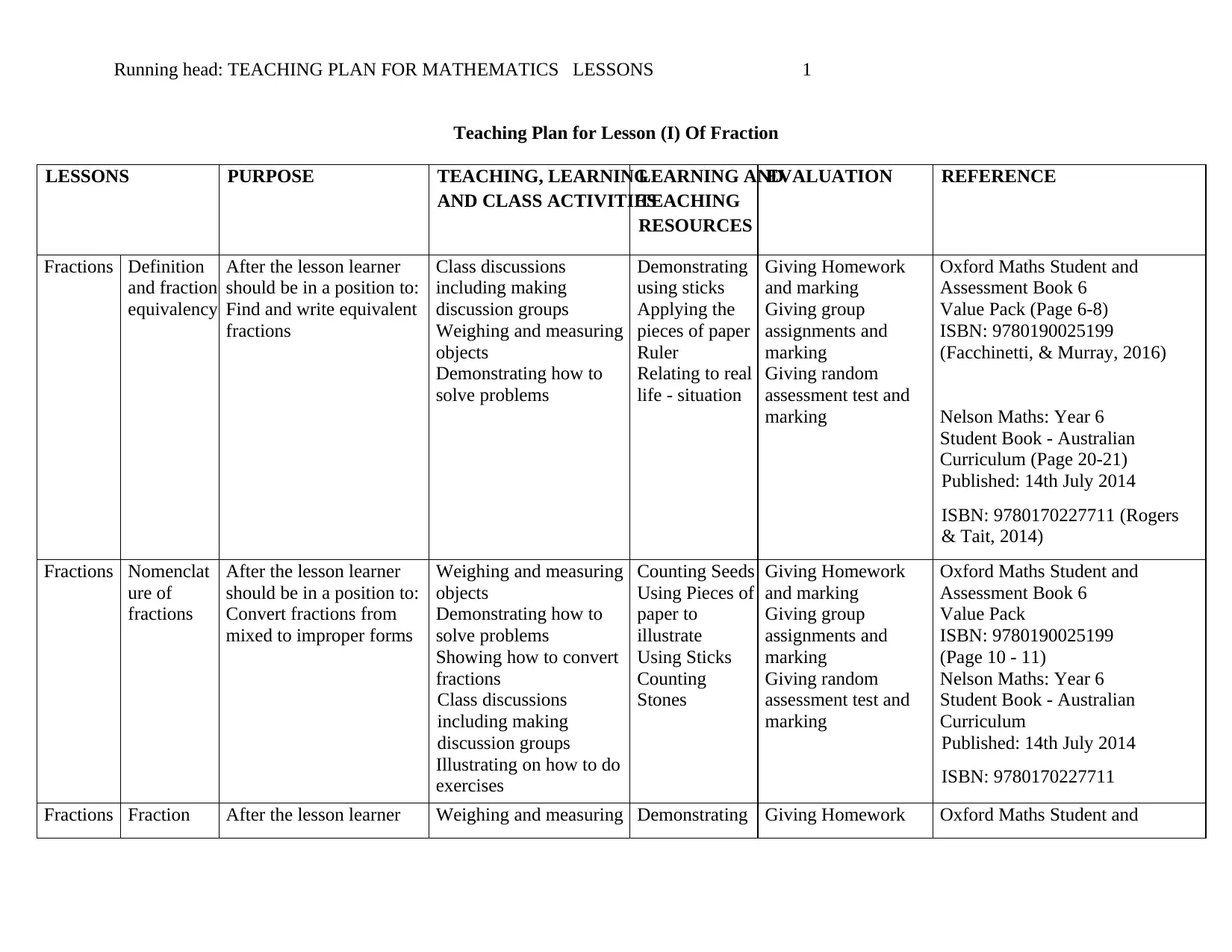
Running head: TEACHING PLAN FOR MATHEMATICS LESSONS 1
Teaching Plan for Lesson (I) Of Fraction
LESSONS PURPOSE TEACHING, LEARNING
AND CLASS ACTIVITIES
LEARNING AND
TEACHING
RESOURCES
EVALUATION REFERENCE
Fractions Definition
and fraction
equivalency
After the lesson learner
should be in a position to:
Find and write equivalent
fractions
Class discussions
including making
discussion groups
Weighing and measuring
objects
Demonstrating how to
solve problems
Demonstrating
using sticks
Applying the
pieces of paper
Ruler
Relating to real
life - situation
Giving Homework
and marking
Giving group
assignments and
marking
Giving random
assessment test and
marking
Oxford Maths Student and
Assessment Book 6
Value Pack (Page 6-8)
ISBN: 9780190025199
(Facchinetti, & Murray, 2016)
Nelson Maths: Year 6
Student Book - Australian
Curriculum (Page 20-21)
Published: 14th July 2014
ISBN: 9780170227711 (Rogers
& Tait, 2014)
Fractions Nomenclat
ure of
fractions
After the lesson learner
should be in a position to:
Convert fractions from
mixed to improper forms
Weighing and measuring
objects
Demonstrating how to
solve problems
Showing how to convert
fractions
Class discussions
including making
discussion groups
Illustrating on how to do
exercises
Counting Seeds
Using Pieces of
paper to
illustrate
Using Sticks
Counting
Stones
Giving Homework
and marking
Giving group
assignments and
marking
Giving random
assessment test and
marking
Oxford Maths Student and
Assessment Book 6
Value Pack
ISBN: 9780190025199
(Page 10 - 11)
Nelson Maths: Year 6
Student Book - Australian
Curriculum
Published: 14th July 2014
ISBN: 9780170227711
Fractions Fraction After the lesson learner Weighing and measuring Demonstrating Giving Homework Oxford Maths Student and
Teaching Plan for Lesson (I) Of Fraction
LESSONS PURPOSE TEACHING, LEARNING
AND CLASS ACTIVITIES
LEARNING AND
TEACHING
RESOURCES
EVALUATION REFERENCE
Fractions Definition
and fraction
equivalency
After the lesson learner
should be in a position to:
Find and write equivalent
fractions
Class discussions
including making
discussion groups
Weighing and measuring
objects
Demonstrating how to
solve problems
Demonstrating
using sticks
Applying the
pieces of paper
Ruler
Relating to real
life - situation
Giving Homework
and marking
Giving group
assignments and
marking
Giving random
assessment test and
marking
Oxford Maths Student and
Assessment Book 6
Value Pack (Page 6-8)
ISBN: 9780190025199
(Facchinetti, & Murray, 2016)
Nelson Maths: Year 6
Student Book - Australian
Curriculum (Page 20-21)
Published: 14th July 2014
ISBN: 9780170227711 (Rogers
& Tait, 2014)
Fractions Nomenclat
ure of
fractions
After the lesson learner
should be in a position to:
Convert fractions from
mixed to improper forms
Weighing and measuring
objects
Demonstrating how to
solve problems
Showing how to convert
fractions
Class discussions
including making
discussion groups
Illustrating on how to do
exercises
Counting Seeds
Using Pieces of
paper to
illustrate
Using Sticks
Counting
Stones
Giving Homework
and marking
Giving group
assignments and
marking
Giving random
assessment test and
marking
Oxford Maths Student and
Assessment Book 6
Value Pack
ISBN: 9780190025199
(Page 10 - 11)
Nelson Maths: Year 6
Student Book - Australian
Curriculum
Published: 14th July 2014
ISBN: 9780170227711
Fractions Fraction After the lesson learner Weighing and measuring Demonstrating Giving Homework Oxford Maths Student and

TEACHING PLAN FOR MATHEMATICS LESSONS 3
Subtraction
and
addition
should be in a position to:
Perform fraction addition
and multiplication
objects
Demonstrating how to
solve problems
Showing how to add and
subtract fractions
using oranges
Counting sticks
Using Pieces of
paper in
demonstration
and marking
Giving group
assignments and
marking
Giving random
assessment test and
marking
Assessment Book 6
Value Pack
ISBN: 9780190025199
(Page 12)
Nelson Maths: Year 6
Student Book - Australian
Curriculum
Published: 14th July 2014
ISBN: 9780170227711
Fractions Fraction
division
and
Multiplicati
on
After the lesson learner
should be in a position to:
Divide and multiply
fractions
Class discussions
including making
discussion groups
Weighing and measuring
objects
Demonstrating how to
solve problems
Using Sticks
Counting
Stones
Counting Seeds
Using Pieces of
paper to
illustrate
Giving Homework
and marking
Giving group
assignments and
marking
Giving random
assessment test and
marking
Oxford Maths Student and
Assessment Book 6
Value Pack
ISBN: 9780190025199
(Page 13-14)
Nelson Maths: Year 6
Student Book - Australian
Curriculum
Published: 14th July 2014
ISBN: 9780170227711
Fractions BODMAS (
order of
Fraction
operations )
After the lesson learner
should be in a position to:
Solve combined
operations on fractions
using BODMAS order
Weighing and measuring
objects
Demonstrating how to
solve problems
Showing how to add,
multiply, divide, subtract
and convert fractions
Mathematical
tables:
conversion and
multiplication
table
Demonstration
by use of real
environmental
objects
Giving Homework
and marking
Giving group
assignments and
marking
Giving random
assessment test and
marking
Oxford Maths Student and
Assessment Book 6
Value Pack
ISBN: 9780190025199
(Page 15)
Nelson Maths: Year 6
Student Book - Australian
Curriculum
Subtraction
and
addition
should be in a position to:
Perform fraction addition
and multiplication
objects
Demonstrating how to
solve problems
Showing how to add and
subtract fractions
using oranges
Counting sticks
Using Pieces of
paper in
demonstration
and marking
Giving group
assignments and
marking
Giving random
assessment test and
marking
Assessment Book 6
Value Pack
ISBN: 9780190025199
(Page 12)
Nelson Maths: Year 6
Student Book - Australian
Curriculum
Published: 14th July 2014
ISBN: 9780170227711
Fractions Fraction
division
and
Multiplicati
on
After the lesson learner
should be in a position to:
Divide and multiply
fractions
Class discussions
including making
discussion groups
Weighing and measuring
objects
Demonstrating how to
solve problems
Using Sticks
Counting
Stones
Counting Seeds
Using Pieces of
paper to
illustrate
Giving Homework
and marking
Giving group
assignments and
marking
Giving random
assessment test and
marking
Oxford Maths Student and
Assessment Book 6
Value Pack
ISBN: 9780190025199
(Page 13-14)
Nelson Maths: Year 6
Student Book - Australian
Curriculum
Published: 14th July 2014
ISBN: 9780170227711
Fractions BODMAS (
order of
Fraction
operations )
After the lesson learner
should be in a position to:
Solve combined
operations on fractions
using BODMAS order
Weighing and measuring
objects
Demonstrating how to
solve problems
Showing how to add,
multiply, divide, subtract
and convert fractions
Mathematical
tables:
conversion and
multiplication
table
Demonstration
by use of real
environmental
objects
Giving Homework
and marking
Giving group
assignments and
marking
Giving random
assessment test and
marking
Oxford Maths Student and
Assessment Book 6
Value Pack
ISBN: 9780190025199
(Page 15)
Nelson Maths: Year 6
Student Book - Australian
Curriculum
⊘ This is a preview!⊘
Do you want full access?
Subscribe today to unlock all pages.

Trusted by 1+ million students worldwide
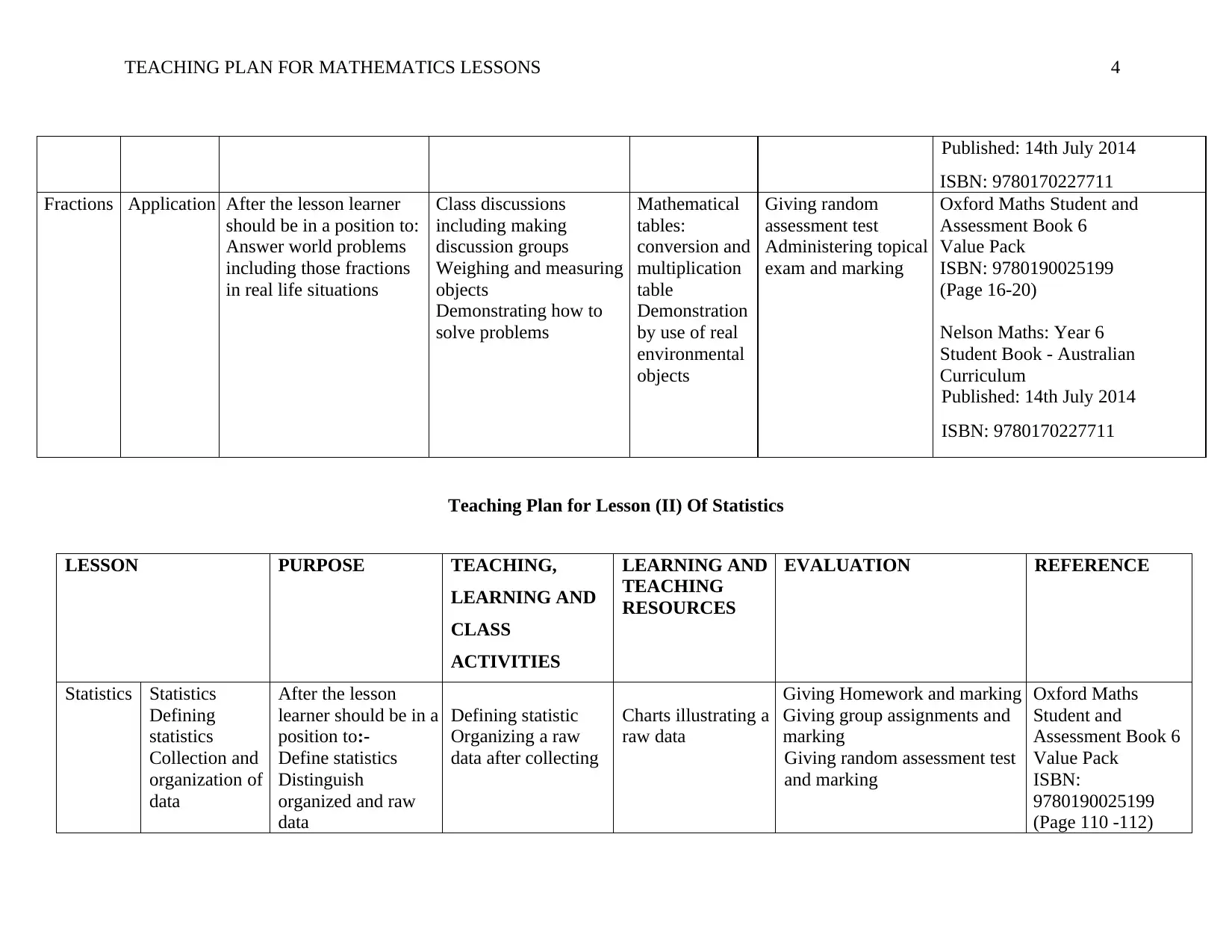
TEACHING PLAN FOR MATHEMATICS LESSONS 4
Published: 14th July 2014
ISBN: 9780170227711
Fractions Application After the lesson learner
should be in a position to:
Answer world problems
including those fractions
in real life situations
Class discussions
including making
discussion groups
Weighing and measuring
objects
Demonstrating how to
solve problems
Mathematical
tables:
conversion and
multiplication
table
Demonstration
by use of real
environmental
objects
Giving random
assessment test
Administering topical
exam and marking
Oxford Maths Student and
Assessment Book 6
Value Pack
ISBN: 9780190025199
(Page 16-20)
Nelson Maths: Year 6
Student Book - Australian
Curriculum
Published: 14th July 2014
ISBN: 9780170227711
Teaching Plan for Lesson (II) Of Statistics
LESSON PURPOSE TEACHING,
LEARNING AND
CLASS
ACTIVITIES
LEARNING AND
TEACHING
RESOURCES
EVALUATION REFERENCE
Statistics Statistics
Defining
statistics
Collection and
organization of
data
After the lesson
learner should be in a
position to:-
Define statistics
Distinguish
organized and raw
data
Defining statistic
Organizing a raw
data after collecting
Charts illustrating a
raw data
Giving Homework and marking
Giving group assignments and
marking
Giving random assessment test
and marking
Oxford Maths
Student and
Assessment Book 6
Value Pack
ISBN:
9780190025199
(Page 110 -112)
Published: 14th July 2014
ISBN: 9780170227711
Fractions Application After the lesson learner
should be in a position to:
Answer world problems
including those fractions
in real life situations
Class discussions
including making
discussion groups
Weighing and measuring
objects
Demonstrating how to
solve problems
Mathematical
tables:
conversion and
multiplication
table
Demonstration
by use of real
environmental
objects
Giving random
assessment test
Administering topical
exam and marking
Oxford Maths Student and
Assessment Book 6
Value Pack
ISBN: 9780190025199
(Page 16-20)
Nelson Maths: Year 6
Student Book - Australian
Curriculum
Published: 14th July 2014
ISBN: 9780170227711
Teaching Plan for Lesson (II) Of Statistics
LESSON PURPOSE TEACHING,
LEARNING AND
CLASS
ACTIVITIES
LEARNING AND
TEACHING
RESOURCES
EVALUATION REFERENCE
Statistics Statistics
Defining
statistics
Collection and
organization of
data
After the lesson
learner should be in a
position to:-
Define statistics
Distinguish
organized and raw
data
Defining statistic
Organizing a raw
data after collecting
Charts illustrating a
raw data
Giving Homework and marking
Giving group assignments and
marking
Giving random assessment test
and marking
Oxford Maths
Student and
Assessment Book 6
Value Pack
ISBN:
9780190025199
(Page 110 -112)
Paraphrase This Document
Need a fresh take? Get an instant paraphrase of this document with our AI Paraphraser
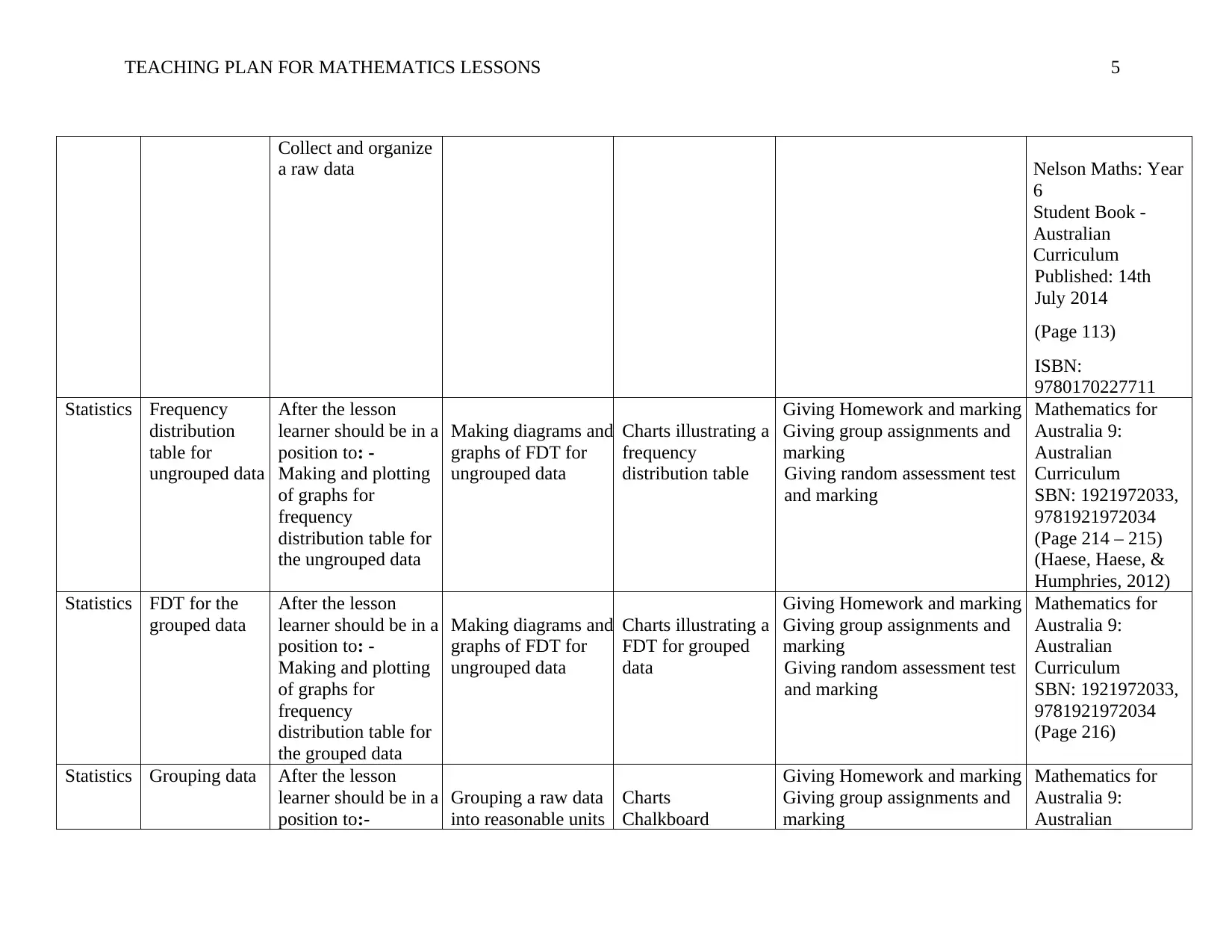
TEACHING PLAN FOR MATHEMATICS LESSONS 5
Collect and organize
a raw data Nelson Maths: Year
6
Student Book -
Australian
Curriculum
Published: 14th
July 2014
(Page 113)
ISBN:
9780170227711
Statistics Frequency
distribution
table for
ungrouped data
After the lesson
learner should be in a
position to: -
Making and plotting
of graphs for
frequency
distribution table for
the ungrouped data
Making diagrams and
graphs of FDT for
ungrouped data
Charts illustrating a
frequency
distribution table
Giving Homework and marking
Giving group assignments and
marking
Giving random assessment test
and marking
Mathematics for
Australia 9:
Australian
Curriculum
SBN: 1921972033,
9781921972034
(Page 214 – 215)
(Haese, Haese, &
Humphries, 2012)
Statistics FDT for the
grouped data
After the lesson
learner should be in a
position to: -
Making and plotting
of graphs for
frequency
distribution table for
the grouped data
Making diagrams and
graphs of FDT for
ungrouped data
Charts illustrating a
FDT for grouped
data
Giving Homework and marking
Giving group assignments and
marking
Giving random assessment test
and marking
Mathematics for
Australia 9:
Australian
Curriculum
SBN: 1921972033,
9781921972034
(Page 216)
Statistics Grouping data After the lesson
learner should be in a
position to:-
Grouping a raw data
into reasonable units
Charts
Chalkboard
Giving Homework and marking
Giving group assignments and
marking
Mathematics for
Australia 9:
Australian
Collect and organize
a raw data Nelson Maths: Year
6
Student Book -
Australian
Curriculum
Published: 14th
July 2014
(Page 113)
ISBN:
9780170227711
Statistics Frequency
distribution
table for
ungrouped data
After the lesson
learner should be in a
position to: -
Making and plotting
of graphs for
frequency
distribution table for
the ungrouped data
Making diagrams and
graphs of FDT for
ungrouped data
Charts illustrating a
frequency
distribution table
Giving Homework and marking
Giving group assignments and
marking
Giving random assessment test
and marking
Mathematics for
Australia 9:
Australian
Curriculum
SBN: 1921972033,
9781921972034
(Page 214 – 215)
(Haese, Haese, &
Humphries, 2012)
Statistics FDT for the
grouped data
After the lesson
learner should be in a
position to: -
Making and plotting
of graphs for
frequency
distribution table for
the grouped data
Making diagrams and
graphs of FDT for
ungrouped data
Charts illustrating a
FDT for grouped
data
Giving Homework and marking
Giving group assignments and
marking
Giving random assessment test
and marking
Mathematics for
Australia 9:
Australian
Curriculum
SBN: 1921972033,
9781921972034
(Page 216)
Statistics Grouping data After the lesson
learner should be in a
position to:-
Grouping a raw data
into reasonable units
Charts
Chalkboard
Giving Homework and marking
Giving group assignments and
marking
Mathematics for
Australia 9:
Australian
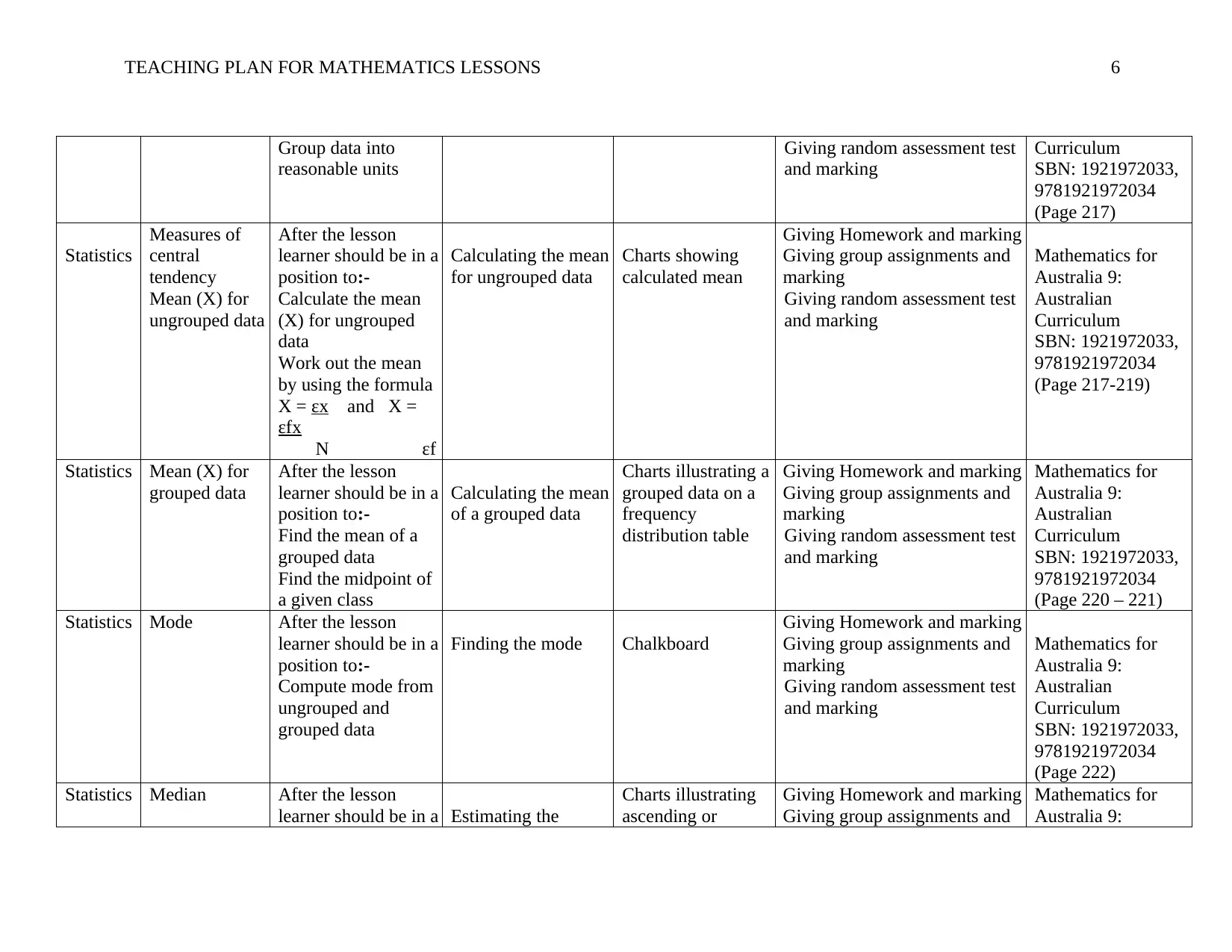
TEACHING PLAN FOR MATHEMATICS LESSONS 6
Group data into
reasonable units
Giving random assessment test
and marking
Curriculum
SBN: 1921972033,
9781921972034
(Page 217)
Statistics
Measures of
central
tendency
Mean (X) for
ungrouped data
After the lesson
learner should be in a
position to:-
Calculate the mean
(X) for ungrouped
data
Work out the mean
by using the formula
X = εx and X =
εfx
N εf
Calculating the mean
for ungrouped data
Charts showing
calculated mean
Giving Homework and marking
Giving group assignments and
marking
Giving random assessment test
and marking
Mathematics for
Australia 9:
Australian
Curriculum
SBN: 1921972033,
9781921972034
(Page 217-219)
Statistics Mean (X) for
grouped data
After the lesson
learner should be in a
position to:-
Find the mean of a
grouped data
Find the midpoint of
a given class
Calculating the mean
of a grouped data
Charts illustrating a
grouped data on a
frequency
distribution table
Giving Homework and marking
Giving group assignments and
marking
Giving random assessment test
and marking
Mathematics for
Australia 9:
Australian
Curriculum
SBN: 1921972033,
9781921972034
(Page 220 – 221)
Statistics Mode After the lesson
learner should be in a
position to:-
Compute mode from
ungrouped and
grouped data
Finding the mode Chalkboard
Giving Homework and marking
Giving group assignments and
marking
Giving random assessment test
and marking
Mathematics for
Australia 9:
Australian
Curriculum
SBN: 1921972033,
9781921972034
(Page 222)
Statistics Median After the lesson
learner should be in a Estimating the
Charts illustrating
ascending or
Giving Homework and marking
Giving group assignments and
Mathematics for
Australia 9:
Group data into
reasonable units
Giving random assessment test
and marking
Curriculum
SBN: 1921972033,
9781921972034
(Page 217)
Statistics
Measures of
central
tendency
Mean (X) for
ungrouped data
After the lesson
learner should be in a
position to:-
Calculate the mean
(X) for ungrouped
data
Work out the mean
by using the formula
X = εx and X =
εfx
N εf
Calculating the mean
for ungrouped data
Charts showing
calculated mean
Giving Homework and marking
Giving group assignments and
marking
Giving random assessment test
and marking
Mathematics for
Australia 9:
Australian
Curriculum
SBN: 1921972033,
9781921972034
(Page 217-219)
Statistics Mean (X) for
grouped data
After the lesson
learner should be in a
position to:-
Find the mean of a
grouped data
Find the midpoint of
a given class
Calculating the mean
of a grouped data
Charts illustrating a
grouped data on a
frequency
distribution table
Giving Homework and marking
Giving group assignments and
marking
Giving random assessment test
and marking
Mathematics for
Australia 9:
Australian
Curriculum
SBN: 1921972033,
9781921972034
(Page 220 – 221)
Statistics Mode After the lesson
learner should be in a
position to:-
Compute mode from
ungrouped and
grouped data
Finding the mode Chalkboard
Giving Homework and marking
Giving group assignments and
marking
Giving random assessment test
and marking
Mathematics for
Australia 9:
Australian
Curriculum
SBN: 1921972033,
9781921972034
(Page 222)
Statistics Median After the lesson
learner should be in a Estimating the
Charts illustrating
ascending or
Giving Homework and marking
Giving group assignments and
Mathematics for
Australia 9:
⊘ This is a preview!⊘
Do you want full access?
Subscribe today to unlock all pages.

Trusted by 1+ million students worldwide
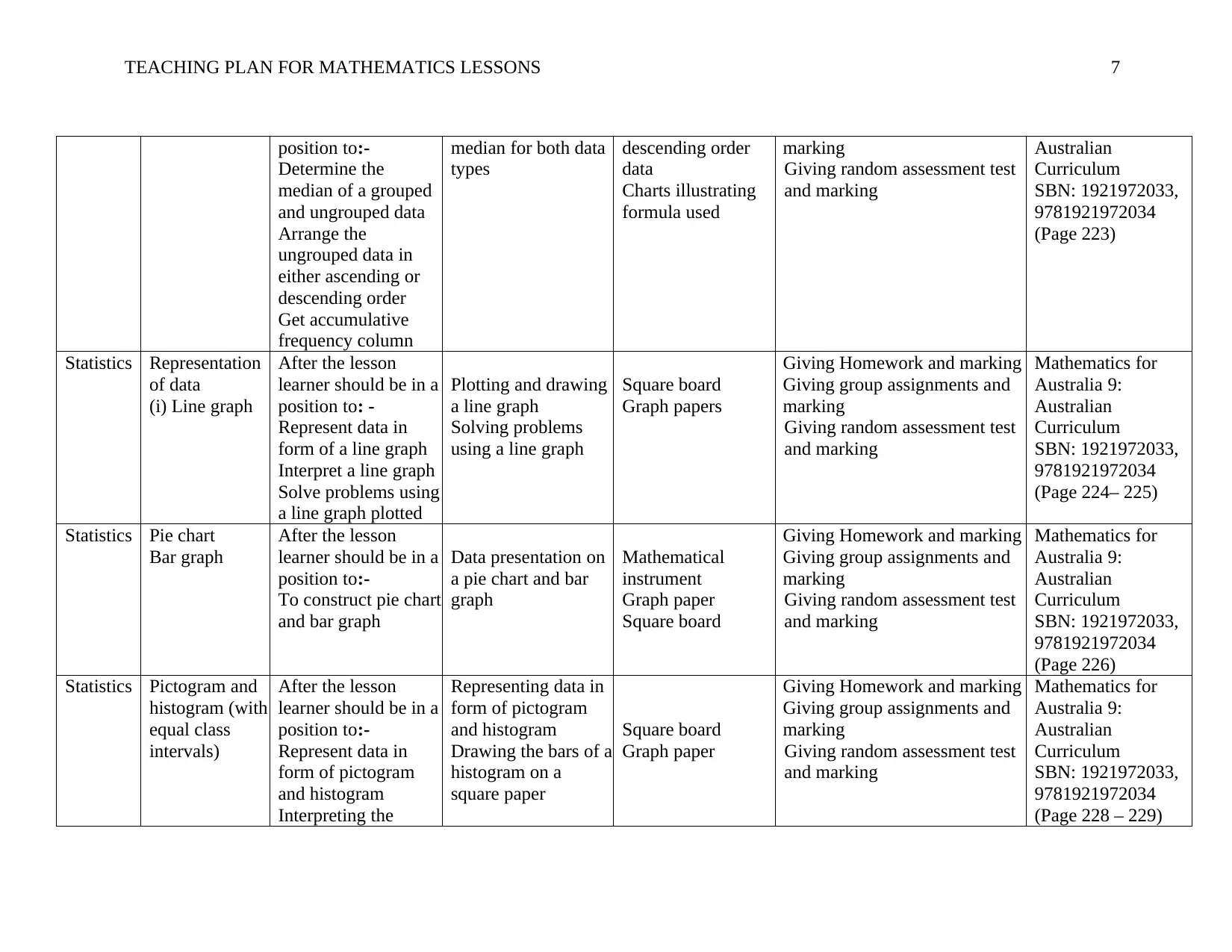
TEACHING PLAN FOR MATHEMATICS LESSONS 7
position to:-
Determine the
median of a grouped
and ungrouped data
Arrange the
ungrouped data in
either ascending or
descending order
Get accumulative
frequency column
median for both data
types
descending order
data
Charts illustrating
formula used
marking
Giving random assessment test
and marking
Australian
Curriculum
SBN: 1921972033,
9781921972034
(Page 223)
Statistics Representation
of data
(i) Line graph
After the lesson
learner should be in a
position to: -
Represent data in
form of a line graph
Interpret a line graph
Solve problems using
a line graph plotted
Plotting and drawing
a line graph
Solving problems
using a line graph
Square board
Graph papers
Giving Homework and marking
Giving group assignments and
marking
Giving random assessment test
and marking
Mathematics for
Australia 9:
Australian
Curriculum
SBN: 1921972033,
9781921972034
(Page 224– 225)
Statistics Pie chart
Bar graph
After the lesson
learner should be in a
position to:-
To construct pie chart
and bar graph
Data presentation on
a pie chart and bar
graph
Mathematical
instrument
Graph paper
Square board
Giving Homework and marking
Giving group assignments and
marking
Giving random assessment test
and marking
Mathematics for
Australia 9:
Australian
Curriculum
SBN: 1921972033,
9781921972034
(Page 226)
Statistics Pictogram and
histogram (with
equal class
intervals)
After the lesson
learner should be in a
position to:-
Represent data in
form of pictogram
and histogram
Interpreting the
Representing data in
form of pictogram
and histogram
Drawing the bars of a
histogram on a
square paper
Square board
Graph paper
Giving Homework and marking
Giving group assignments and
marking
Giving random assessment test
and marking
Mathematics for
Australia 9:
Australian
Curriculum
SBN: 1921972033,
9781921972034
(Page 228 – 229)
position to:-
Determine the
median of a grouped
and ungrouped data
Arrange the
ungrouped data in
either ascending or
descending order
Get accumulative
frequency column
median for both data
types
descending order
data
Charts illustrating
formula used
marking
Giving random assessment test
and marking
Australian
Curriculum
SBN: 1921972033,
9781921972034
(Page 223)
Statistics Representation
of data
(i) Line graph
After the lesson
learner should be in a
position to: -
Represent data in
form of a line graph
Interpret a line graph
Solve problems using
a line graph plotted
Plotting and drawing
a line graph
Solving problems
using a line graph
Square board
Graph papers
Giving Homework and marking
Giving group assignments and
marking
Giving random assessment test
and marking
Mathematics for
Australia 9:
Australian
Curriculum
SBN: 1921972033,
9781921972034
(Page 224– 225)
Statistics Pie chart
Bar graph
After the lesson
learner should be in a
position to:-
To construct pie chart
and bar graph
Data presentation on
a pie chart and bar
graph
Mathematical
instrument
Graph paper
Square board
Giving Homework and marking
Giving group assignments and
marking
Giving random assessment test
and marking
Mathematics for
Australia 9:
Australian
Curriculum
SBN: 1921972033,
9781921972034
(Page 226)
Statistics Pictogram and
histogram (with
equal class
intervals)
After the lesson
learner should be in a
position to:-
Represent data in
form of pictogram
and histogram
Interpreting the
Representing data in
form of pictogram
and histogram
Drawing the bars of a
histogram on a
square paper
Square board
Graph paper
Giving Homework and marking
Giving group assignments and
marking
Giving random assessment test
and marking
Mathematics for
Australia 9:
Australian
Curriculum
SBN: 1921972033,
9781921972034
(Page 228 – 229)
Paraphrase This Document
Need a fresh take? Get an instant paraphrase of this document with our AI Paraphraser

TEACHING PLAN FOR MATHEMATICS LESSONS 8
information from the
bars of a histogram
and pictogram
Statistics Histogram
(varying class
interval)
After the lesson
learner should be in a
position to:-
Represent data in a
histogram with
varying class
intervals
Calculate frequency
densities
Calculating
frequency density
Representing data in
form of a histogram
Graph paper
Square board
Giving Homework and marking
Giving group assignments and
marking
Giving random assessment test
and marking
Mathematics for
Australia 9:
Australian
Curriculum
SBN: 1921972033,
9781921972034
(Page 230)
Statistics Frequency
polygons
After the lesson
learner should be in a
position to: -
Represent data a
frequency polygon
Plotting frequency
polygon
Plotting and drawing
frequency polygon
Graph paper
Square board
Giving Homework and marking
Giving group assignments and
marking
Giving random assessment test
and marking
Mathematics for
Australia 9:
Australian
Curriculum
SBN: 1921972033,
9781921972034
(Page 231-232)
Statistics Real life
application of
Statistics
After the lesson
learner should be in a
position to: -
Interpret data from
real life situation
using the knowledge
of line graph, bar
graph, pie chart,
histogram, pictogram
and frequency
polygon
Interpreting of data
in real life situation
by using the
previously learnt
knowledge
Graph paper
Mathematical
instruments
Giving random assessment test
Administering topical exam and
marking
Mathematics for
Australia 9:
Australian
Curriculum
SBN: 1921972033,
9781921972034
(Page 233)
information from the
bars of a histogram
and pictogram
Statistics Histogram
(varying class
interval)
After the lesson
learner should be in a
position to:-
Represent data in a
histogram with
varying class
intervals
Calculate frequency
densities
Calculating
frequency density
Representing data in
form of a histogram
Graph paper
Square board
Giving Homework and marking
Giving group assignments and
marking
Giving random assessment test
and marking
Mathematics for
Australia 9:
Australian
Curriculum
SBN: 1921972033,
9781921972034
(Page 230)
Statistics Frequency
polygons
After the lesson
learner should be in a
position to: -
Represent data a
frequency polygon
Plotting frequency
polygon
Plotting and drawing
frequency polygon
Graph paper
Square board
Giving Homework and marking
Giving group assignments and
marking
Giving random assessment test
and marking
Mathematics for
Australia 9:
Australian
Curriculum
SBN: 1921972033,
9781921972034
(Page 231-232)
Statistics Real life
application of
Statistics
After the lesson
learner should be in a
position to: -
Interpret data from
real life situation
using the knowledge
of line graph, bar
graph, pie chart,
histogram, pictogram
and frequency
polygon
Interpreting of data
in real life situation
by using the
previously learnt
knowledge
Graph paper
Mathematical
instruments
Giving random assessment test
Administering topical exam and
marking
Mathematics for
Australia 9:
Australian
Curriculum
SBN: 1921972033,
9781921972034
(Page 233)
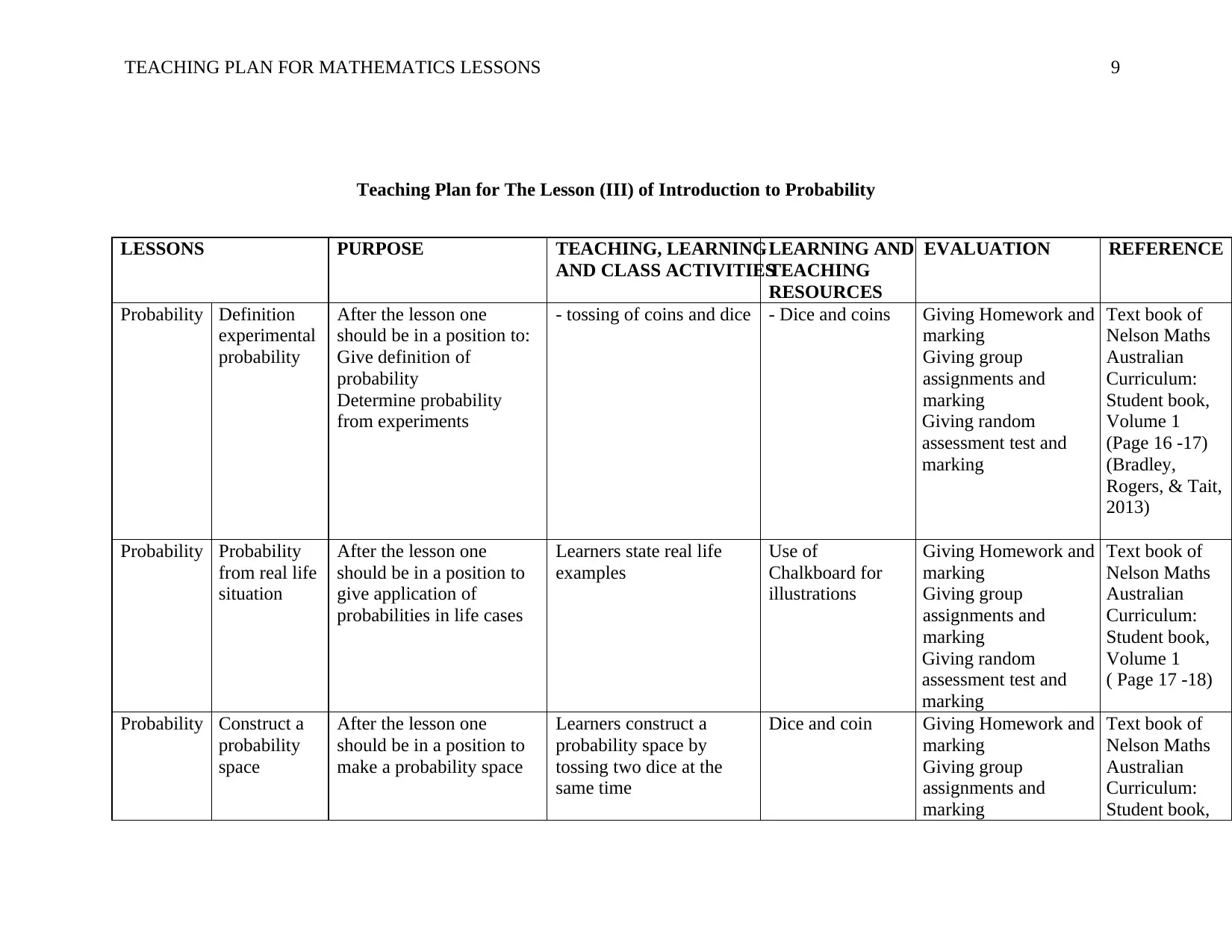
TEACHING PLAN FOR MATHEMATICS LESSONS 9
Teaching Plan for The Lesson (III) of Introduction to Probability
LESSONS PURPOSE TEACHING, LEARNING
AND CLASS ACTIVITIES
LEARNING AND
TEACHING
RESOURCES
EVALUATION REFERENCE
Probability Definition
experimental
probability
After the lesson one
should be in a position to:
Give definition of
probability
Determine probability
from experiments
- tossing of coins and dice - Dice and coins Giving Homework and
marking
Giving group
assignments and
marking
Giving random
assessment test and
marking
Text book of
Nelson Maths
Australian
Curriculum:
Student book,
Volume 1
(Page 16 -17)
(Bradley,
Rogers, & Tait,
2013)
Probability Probability
from real life
situation
After the lesson one
should be in a position to
give application of
probabilities in life cases
Learners state real life
examples
Use of
Chalkboard for
illustrations
Giving Homework and
marking
Giving group
assignments and
marking
Giving random
assessment test and
marking
Text book of
Nelson Maths
Australian
Curriculum:
Student book,
Volume 1
( Page 17 -18)
Probability Construct a
probability
space
After the lesson one
should be in a position to
make a probability space
Learners construct a
probability space by
tossing two dice at the
same time
Dice and coin Giving Homework and
marking
Giving group
assignments and
marking
Text book of
Nelson Maths
Australian
Curriculum:
Student book,
Teaching Plan for The Lesson (III) of Introduction to Probability
LESSONS PURPOSE TEACHING, LEARNING
AND CLASS ACTIVITIES
LEARNING AND
TEACHING
RESOURCES
EVALUATION REFERENCE
Probability Definition
experimental
probability
After the lesson one
should be in a position to:
Give definition of
probability
Determine probability
from experiments
- tossing of coins and dice - Dice and coins Giving Homework and
marking
Giving group
assignments and
marking
Giving random
assessment test and
marking
Text book of
Nelson Maths
Australian
Curriculum:
Student book,
Volume 1
(Page 16 -17)
(Bradley,
Rogers, & Tait,
2013)
Probability Probability
from real life
situation
After the lesson one
should be in a position to
give application of
probabilities in life cases
Learners state real life
examples
Use of
Chalkboard for
illustrations
Giving Homework and
marking
Giving group
assignments and
marking
Giving random
assessment test and
marking
Text book of
Nelson Maths
Australian
Curriculum:
Student book,
Volume 1
( Page 17 -18)
Probability Construct a
probability
space
After the lesson one
should be in a position to
make a probability space
Learners construct a
probability space by
tossing two dice at the
same time
Dice and coin Giving Homework and
marking
Giving group
assignments and
marking
Text book of
Nelson Maths
Australian
Curriculum:
Student book,
⊘ This is a preview!⊘
Do you want full access?
Subscribe today to unlock all pages.

Trusted by 1+ million students worldwide

TEACHING PLAN FOR MATHEMATICS LESSONS 10
Giving random
assessment test and
marking
Volume 1
(Page 18 -19)
Probability Range of
probability
measure
After the lesson one
should be in a position to
identify the range of
probability measure
Learners state the range
of probability
Use of
Chalkboard for
illustrations
Giving Homework and
marking
Giving group
assignments and
marking
Giving random
assessment test and
marking
Text book of
Nelson Maths
Australian
Curriculum:
Student book,
Volume 1
( Page 19 -21)
Probability Theoretical
probability
After the lesson one
should be in a position to
compute theoretical
probability
Learners determine
theoretical probability
Use of
Chalkboard for
illustrations
Giving Homework and
marking
Giving group
assignments and
marking
Giving random
assessment test and
marking
Text book of
Nelson Maths
Australian
Curriculum:
Student book,
Volume 1
(Page 22 - 23)
Probability Discrete
probability
After the lesson one
should be in a position to
explain the meaning of
discrete probability by
computing the probability
Learners give examples
of discrete
probability
Use of
Chalkboard for
illustrations and
calculators
Giving Homework and
marking
Giving group
assignments and
marking
Giving random
assessment test and
marking
Text book of
Nelson Maths
Australian
Curriculum:
Student book,
Volume 1
(Page 24 -25)
Probability Continuous
probability
After the lesson one
should be in a position to
define continuous
probability and determine
the probability
Learners give examples
of continuous
probability
Use of
Chalkboard for
illustrations and
calculators
Giving Homework and
marking
Giving group
assignments and
marking
Text book of
Nelson Maths
Australian
Curriculum:
Student book,
Giving random
assessment test and
marking
Volume 1
(Page 18 -19)
Probability Range of
probability
measure
After the lesson one
should be in a position to
identify the range of
probability measure
Learners state the range
of probability
Use of
Chalkboard for
illustrations
Giving Homework and
marking
Giving group
assignments and
marking
Giving random
assessment test and
marking
Text book of
Nelson Maths
Australian
Curriculum:
Student book,
Volume 1
( Page 19 -21)
Probability Theoretical
probability
After the lesson one
should be in a position to
compute theoretical
probability
Learners determine
theoretical probability
Use of
Chalkboard for
illustrations
Giving Homework and
marking
Giving group
assignments and
marking
Giving random
assessment test and
marking
Text book of
Nelson Maths
Australian
Curriculum:
Student book,
Volume 1
(Page 22 - 23)
Probability Discrete
probability
After the lesson one
should be in a position to
explain the meaning of
discrete probability by
computing the probability
Learners give examples
of discrete
probability
Use of
Chalkboard for
illustrations and
calculators
Giving Homework and
marking
Giving group
assignments and
marking
Giving random
assessment test and
marking
Text book of
Nelson Maths
Australian
Curriculum:
Student book,
Volume 1
(Page 24 -25)
Probability Continuous
probability
After the lesson one
should be in a position to
define continuous
probability and determine
the probability
Learners give examples
of continuous
probability
Use of
Chalkboard for
illustrations and
calculators
Giving Homework and
marking
Giving group
assignments and
marking
Text book of
Nelson Maths
Australian
Curriculum:
Student book,
Paraphrase This Document
Need a fresh take? Get an instant paraphrase of this document with our AI Paraphraser
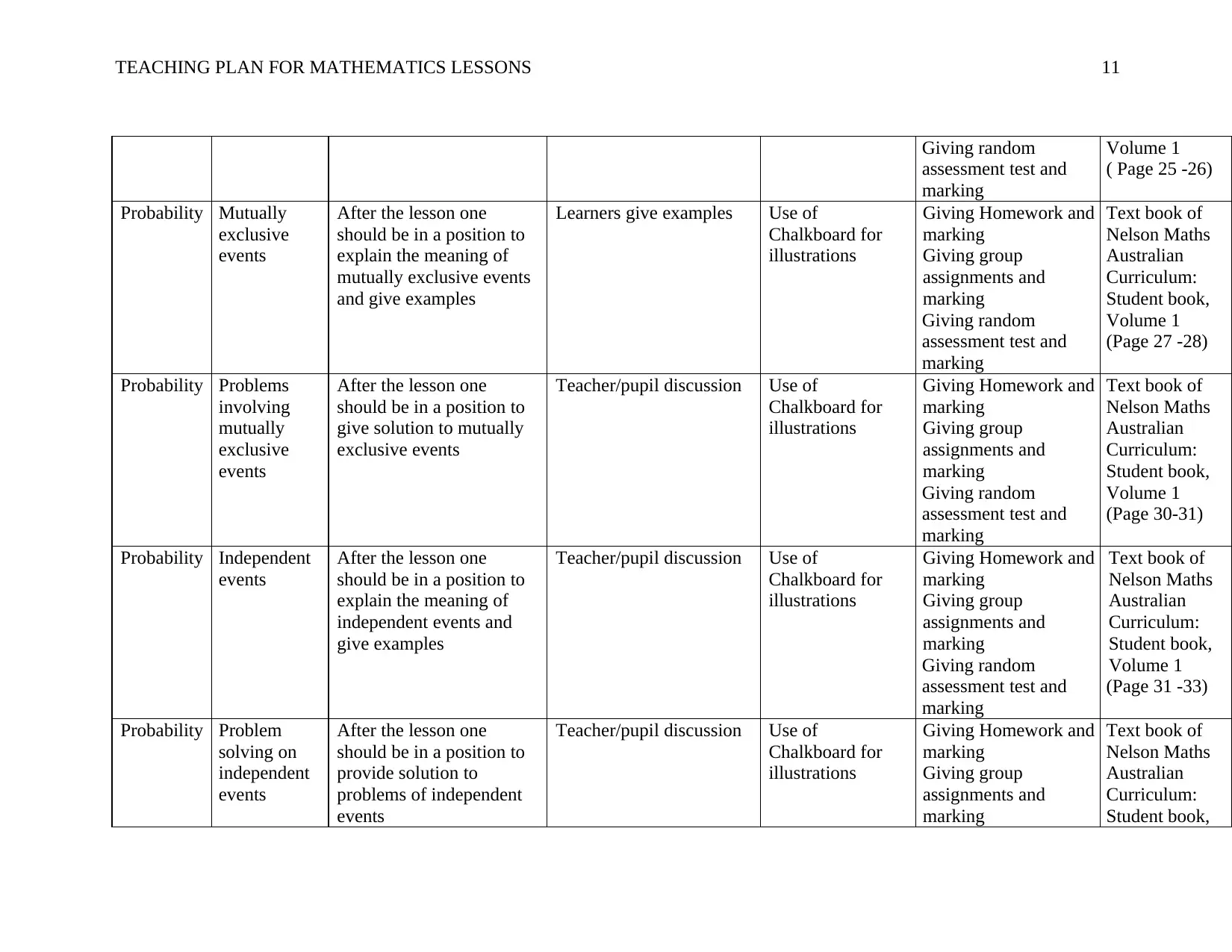
TEACHING PLAN FOR MATHEMATICS LESSONS 11
Giving random
assessment test and
marking
Volume 1
( Page 25 -26)
Probability Mutually
exclusive
events
After the lesson one
should be in a position to
explain the meaning of
mutually exclusive events
and give examples
Learners give examples Use of
Chalkboard for
illustrations
Giving Homework and
marking
Giving group
assignments and
marking
Giving random
assessment test and
marking
Text book of
Nelson Maths
Australian
Curriculum:
Student book,
Volume 1
(Page 27 -28)
Probability Problems
involving
mutually
exclusive
events
After the lesson one
should be in a position to
give solution to mutually
exclusive events
Teacher/pupil discussion Use of
Chalkboard for
illustrations
Giving Homework and
marking
Giving group
assignments and
marking
Giving random
assessment test and
marking
Text book of
Nelson Maths
Australian
Curriculum:
Student book,
Volume 1
(Page 30-31)
Probability Independent
events
After the lesson one
should be in a position to
explain the meaning of
independent events and
give examples
Teacher/pupil discussion Use of
Chalkboard for
illustrations
Giving Homework and
marking
Giving group
assignments and
marking
Giving random
assessment test and
marking
Text book of
Nelson Maths
Australian
Curriculum:
Student book,
Volume 1
(Page 31 -33)
Probability Problem
solving on
independent
events
After the lesson one
should be in a position to
provide solution to
problems of independent
events
Teacher/pupil discussion Use of
Chalkboard for
illustrations
Giving Homework and
marking
Giving group
assignments and
marking
Text book of
Nelson Maths
Australian
Curriculum:
Student book,
Giving random
assessment test and
marking
Volume 1
( Page 25 -26)
Probability Mutually
exclusive
events
After the lesson one
should be in a position to
explain the meaning of
mutually exclusive events
and give examples
Learners give examples Use of
Chalkboard for
illustrations
Giving Homework and
marking
Giving group
assignments and
marking
Giving random
assessment test and
marking
Text book of
Nelson Maths
Australian
Curriculum:
Student book,
Volume 1
(Page 27 -28)
Probability Problems
involving
mutually
exclusive
events
After the lesson one
should be in a position to
give solution to mutually
exclusive events
Teacher/pupil discussion Use of
Chalkboard for
illustrations
Giving Homework and
marking
Giving group
assignments and
marking
Giving random
assessment test and
marking
Text book of
Nelson Maths
Australian
Curriculum:
Student book,
Volume 1
(Page 30-31)
Probability Independent
events
After the lesson one
should be in a position to
explain the meaning of
independent events and
give examples
Teacher/pupil discussion Use of
Chalkboard for
illustrations
Giving Homework and
marking
Giving group
assignments and
marking
Giving random
assessment test and
marking
Text book of
Nelson Maths
Australian
Curriculum:
Student book,
Volume 1
(Page 31 -33)
Probability Problem
solving on
independent
events
After the lesson one
should be in a position to
provide solution to
problems of independent
events
Teacher/pupil discussion Use of
Chalkboard for
illustrations
Giving Homework and
marking
Giving group
assignments and
marking
Text book of
Nelson Maths
Australian
Curriculum:
Student book,
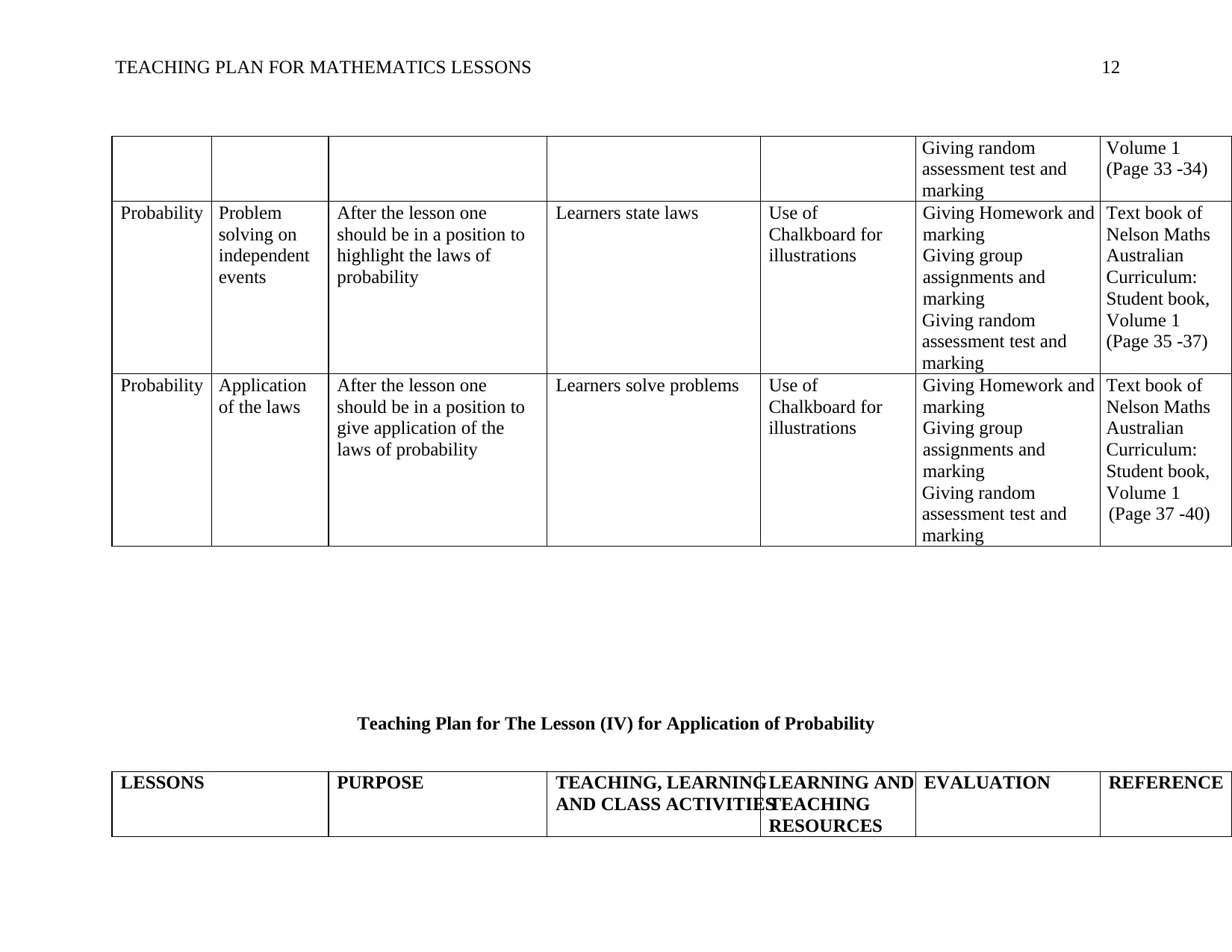
TEACHING PLAN FOR MATHEMATICS LESSONS 12
Giving random
assessment test and
marking
Volume 1
(Page 33 -34)
Probability Problem
solving on
independent
events
After the lesson one
should be in a position to
highlight the laws of
probability
Learners state laws Use of
Chalkboard for
illustrations
Giving Homework and
marking
Giving group
assignments and
marking
Giving random
assessment test and
marking
Text book of
Nelson Maths
Australian
Curriculum:
Student book,
Volume 1
(Page 35 -37)
Probability Application
of the laws
After the lesson one
should be in a position to
give application of the
laws of probability
Learners solve problems Use of
Chalkboard for
illustrations
Giving Homework and
marking
Giving group
assignments and
marking
Giving random
assessment test and
marking
Text book of
Nelson Maths
Australian
Curriculum:
Student book,
Volume 1
(Page 37 -40)
Teaching Plan for The Lesson (IV) for Application of Probability
LESSONS PURPOSE TEACHING, LEARNING
AND CLASS ACTIVITIES
LEARNING AND
TEACHING
RESOURCES
EVALUATION REFERENCE
Giving random
assessment test and
marking
Volume 1
(Page 33 -34)
Probability Problem
solving on
independent
events
After the lesson one
should be in a position to
highlight the laws of
probability
Learners state laws Use of
Chalkboard for
illustrations
Giving Homework and
marking
Giving group
assignments and
marking
Giving random
assessment test and
marking
Text book of
Nelson Maths
Australian
Curriculum:
Student book,
Volume 1
(Page 35 -37)
Probability Application
of the laws
After the lesson one
should be in a position to
give application of the
laws of probability
Learners solve problems Use of
Chalkboard for
illustrations
Giving Homework and
marking
Giving group
assignments and
marking
Giving random
assessment test and
marking
Text book of
Nelson Maths
Australian
Curriculum:
Student book,
Volume 1
(Page 37 -40)
Teaching Plan for The Lesson (IV) for Application of Probability
LESSONS PURPOSE TEACHING, LEARNING
AND CLASS ACTIVITIES
LEARNING AND
TEACHING
RESOURCES
EVALUATION REFERENCE
⊘ This is a preview!⊘
Do you want full access?
Subscribe today to unlock all pages.

Trusted by 1+ million students worldwide
1 out of 15
Your All-in-One AI-Powered Toolkit for Academic Success.
+13062052269
info@desklib.com
Available 24*7 on WhatsApp / Email
![[object Object]](/_next/static/media/star-bottom.7253800d.svg)
Unlock your academic potential
Copyright © 2020–2025 A2Z Services. All Rights Reserved. Developed and managed by ZUCOL.